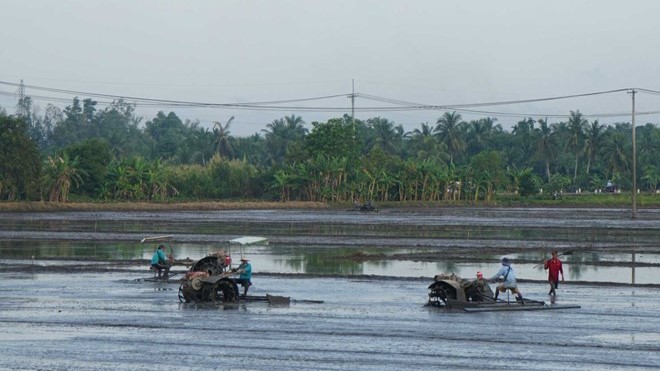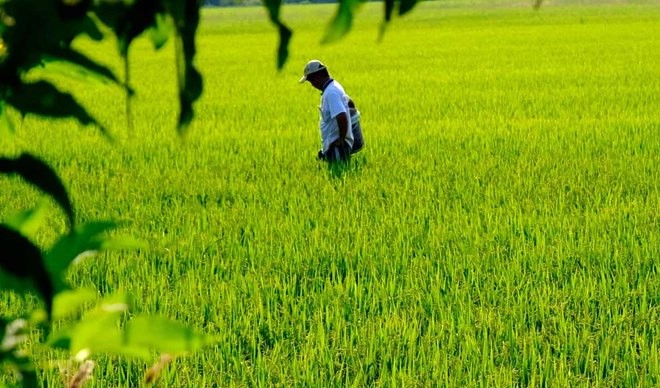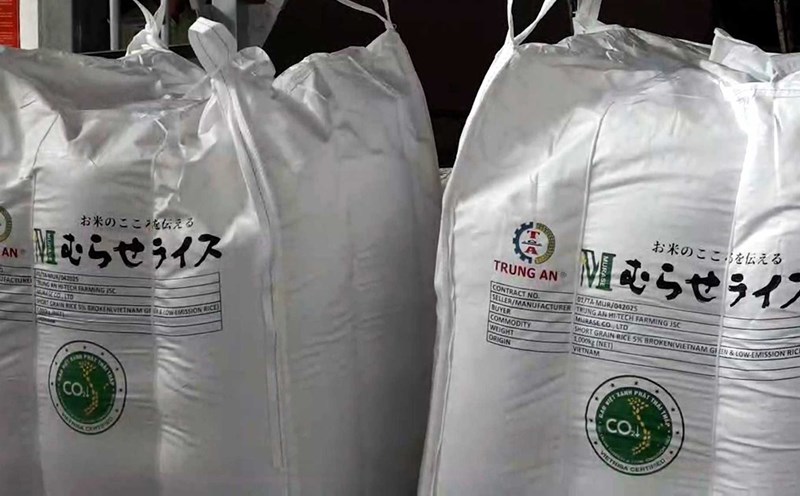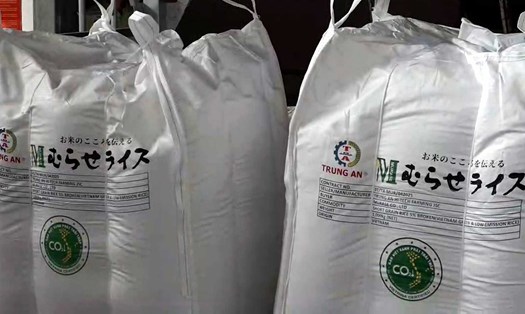Early production, avoiding risks
At the end of the summer-autumn crop, many farming households continue to produce the autumn-winter rice crop to increase income, avoiding the situation of leaving vacant land causing weeds to grow wildly.
As of mid-July 2025, more than 80% of the planned autumn-winter rice area has been planted in the whole city of Can Tho, reaching an area of more than 72,000 hectares. The rice varieties produced by farmers in this crop are OM 5451, OM 18, Dai Thom 8, and ST 24.

Accordingly, the areas of rice in the third crop planted early are in the process of being carried, the rice is growing and developing stably.
Sowing nearly 1.3 hectares of autumn-winter rice, farmer Nguyen Van Tam (Trung Hung commune, Can Tho city) said that although the area has a solid dike, he still takes advantage of sowing early to avoid the risk of storms causing the rice to fall when ripe.
"I planted this crop 20 days earlier, and the rice has now entered the hay-making stage. The rice is less pests-prone and the water level in the fields has not been affected by floods or storms, but I also visit the fields regularly to promptly handle it," said Mr. Tam.
Ms. Ho Thi Nhien (Truong Xuan commune, Can Tho city) is excited with 3.5 hectares of OM 5451 rice that has been 30 days old, healthy and developing well.
"The rice is about to start the barge-building stage, if all goes well, it can be harvested by mid-October. According to some forecasts, the flood will come late this year, so I took advantage of the time to work early to harvest before, to reduce losses," Ms. Nhien shared.
Efforts to reduce input costs
Although rice is developing steadily, the weather is complicated, with more storms and severe heat. In particular, the price of fertilizers, pesticides and labor has increased while the price of rice is flat, which is a difficult problem for farmers.

In that situation, people are actively applying scientific and technical advances to optimize production. Models such as "3 reductions, 3 increases" or "3 must, 5 reductions" are being promoted to save on varieties, fertilizers and pesticides. Many farmers have also proactively linked with each other and businesses to find stable output for their products.
Mr. Tam shared: In the recent summer-autumn crop, with a yield of 700kg/cong and a price of 6,000 VND/kg, he made a profit of about 1.5 million VND/1,000m2. Currently, rice prices have not improved but agricultural materials have increased. Therefore, I try to care for rice according to the recommendations of the agricultural sector to limit production costs".
Similarly, since the beginning of the fall and winter crop, Ms. Nhien has paid attention to the stage of selecting disease-resistant plant varieties to reduce the cost of fertilizers and pesticides, as well as help rice plants grow healthily and safely.
In thunderstorms, for tea that has just been harvested to prepare for the next crop, the Department of Agriculture of Can Tho City recommends that farmers need to clean their fields and fertilize the lion's droppings right from the beginning of the crop to limit the phenomenon of organic poisoning and ensure a spread time between the two crops of 3 weeks or more.
According to the update from the Department of Agriculture and Environment of An Giang province, the price of IR 50404 (fresh) rice today fluctuates at 5,700 - 5,900 VND/kg; Nang Hoa 9 rice fluctuates at 6,000 - 6,200 VND/kg; Dai Thom 8 rice (fresh) fluctuates at 6,100 - 6,200 VND/kg; OM 18 rice (fresh) fluctuates at 6,000 - 6,200 VND/kg; OM 5451 rice (fresh) fluctuates at 5,900 - 6,000 VND/kg.










